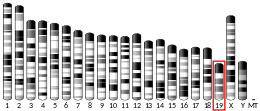PKD2L1
Polycystic kidney disease 2-like 1 protein also known as transient receptor potential polycystic 3 (TRPP3) is a protein that in humans is encoded by the PKD2L1 gene.[5]
Function
TRPP3 is a member of the polycystin protein family. TRPP3 contains multiple transmembrane domains, and cytoplasmic N- and C-termini. TRPP3 may be an integral membrane protein involved in cell-cell/matrix interactions. TRPP3 functions as a calcium-regulated nonselective cation channel. Alternative splice variants have been described but their full length sequences have not been determined.[5]
See also
References
- GRCh38: Ensembl release 89: ENSG00000107593 - Ensembl, May 2017
- GRCm38: Ensembl release 89: ENSMUSG00000037578 - Ensembl, May 2017
- "Human PubMed Reference:". National Center for Biotechnology Information, U.S. National Library of Medicine.
- "Mouse PubMed Reference:". National Center for Biotechnology Information, U.S. National Library of Medicine.
- "Entrez Gene: PKD2L1 polycystic kidney disease 2-like 1".
- Li Q, Liu Y, Shen PY, Dai XQ, Wang S, Smillie LB, Sandford R, Chen XZ (June 2003). "Troponin I binds polycystin-L and inhibits its calcium-induced channel activation". Biochemistry. 42 (24): 7618–25. doi:10.1021/bi034210a. PMID 12809519.
Further reading
- Geng L, Okuhara D, Yu Z, et al. (2006). "Polycystin-2 traffics to cilia independently of polycystin-1 by using an N-terminal RVxP motif". J. Cell Sci. 119 (Pt 7): 1383–95. doi:10.1242/jcs.02818. PMID 16537653.
- Gerhard DS, Wagner L, Feingold EA, et al. (2004). "The status, quality, and expansion of the NIH full-length cDNA project: the Mammalian Gene Collection (MGC)". Genome Res. 14 (10B): 2121–7. doi:10.1101/gr.2596504. PMC 528928. PMID 15489334.
- Li Q, Liu Y, Shen PY, et al. (2003). "Troponin I binds polycystin-L and inhibits its calcium-induced channel activation". Biochemistry. 42 (24): 7618–25. doi:10.1021/bi034210a. PMID 12809519.
- Strausberg RL, Feingold EA, Grouse LH, et al. (2003). "Generation and initial analysis of more than 15,000 full-length human and mouse cDNA sequences". Proc. Natl. Acad. Sci. U.S.A. 99 (26): 16899–903. doi:10.1073/pnas.242603899. PMC 139241. PMID 12477932.
- Li Q, Liu Y, Zhao W, Chen XZ (2002). "The calcium-binding EF-hand in polycystin-L is not a domain for channel activation and ensuing inactivation". FEBS Lett. 516 (1–3): 270–8. doi:10.1016/S0014-5793(02)02513-9. PMID 11959145.
- Basora N, Nomura H, Berger UV, et al. (2002). "Tissue and cellular localization of a novel polycystic kidney disease-like gene product, polycystin-L". J. Am. Soc. Nephrol. 13 (2): 293–301. PMID 11805156.
- Stayner C, Zhou J (2001). "Polycystin channels and kidney disease". Trends Pharmacol. Sci. 22 (11): 543–6. doi:10.1016/S0165-6147(00)01832-0. PMID 11698076.
- Guo L, Chen M, Basora N, Zhou J (2000). "The human polycystic kidney disease 2-like (PKDL) gene: exon/intron structure and evidence for a novel splicing mechanism". Mamm. Genome. 11 (1): 46–50. doi:10.1007/s003350010009. PMID 10602992.
- Veldhuisen B, Spruit L, Dauwerse HG, et al. (2000). "Genes homologous to the autosomal dominant polycystic kidney disease genes (PKD1 and PKD2)". Eur. J. Hum. Genet. 7 (8): 860–72. doi:10.1038/sj.ejhg.5200383. PMID 10602361.
- Chen XZ, Vassilev PM, Basora N, et al. (1999). "Polycystin-L is a calcium-regulated cation channel permeable to calcium ions". Nature. 401 (6751): 383–6. doi:10.1038/43907. PMID 10517637.
- Tsiokas L, Arnould T, Zhu C, et al. (1999). "Specific association of the gene product of PKD2 with the TRPC1 channel". Proc. Natl. Acad. Sci. U.S.A. 96 (7): 3934–9. doi:10.1073/pnas.96.7.3934. PMC 22398. PMID 10097141.
- Wu G, Hayashi T, Park JH, et al. (1999). "Identification of PKD2L, a human PKD2-related gene: tissue-specific expression and mapping to chromosome 10q25". Genomics. 54 (3): 564–8. doi:10.1006/geno.1998.5618. PMID 9878261.
- Nomura H, Turco AE, Pei Y, et al. (1998). "Identification of PKDL, a novel polycystic kidney disease 2-like gene whose murine homologue is deleted in mice with kidney and retinal defects". J. Biol. Chem. 273 (40): 25967–73. doi:10.1074/jbc.273.40.25967. PMID 9748274.
This article is issued from Wikipedia. The text is licensed under Creative Commons - Attribution - Sharealike. Additional terms may apply for the media files.




